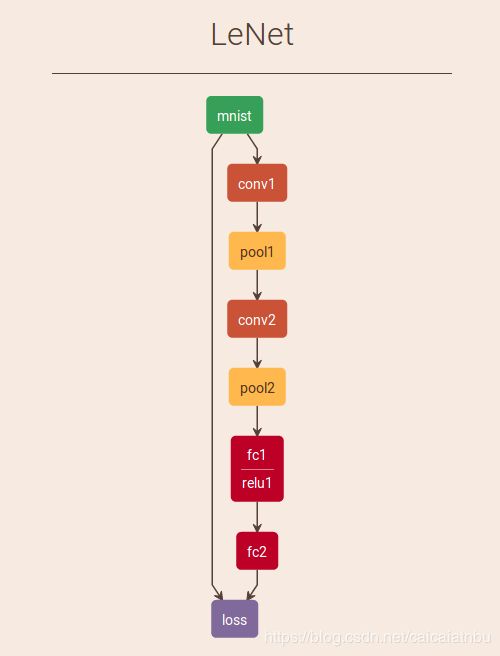Caffe经典模型——图像分类LeNet-5
- LeNet网络框架如下图:
LeNet-5 包括输入层一共8层,每一层都包含多个参数(权重和偏置).
第一层: 输入层大小32*32,但是Caffe中MNIST数据集中的图片大小都是28*28,这样设计是为了让潜在的明显特征(笔画断续,角点)能够出现在最高层特征检测子感受野的中心.
第二层: 卷积层,卷积核大小 5 * 5, 步长为1, 卷积模板数 6, 对输入层进行卷积操作后,得到的特征图大小为 (32 - 5 + 1) * (32 - 5 + 1) = 28 * 28, 通过C1层的卷积操作,使得原始信号特征增强,并降低了噪声,而且不同的卷积核能够提取图像中不同的特征;
第三层: 池化层, 滑动窗口大小 2 * 2, 滑动步长 2, 对C1层进行最大化池化操作后,得到的特征图带下为 28 / 2 * 28 / 2 = 14 * 14,
第四层:卷积层, 卷积核大小 5 * 5, 步长为1, 卷积模板数 16, 对S2层进行卷积操作后,得到的特征图大小为 (14 - 5 + 1) * (14 - 5 + 1) = 10 * 10,
第五层: 池化层, 滑动窗口 2 * 2 , 滑动步长 2, 对 C3 层进行最大化池化操作后,得到的特征图大小为 10 / 2 * 10 / 2 = 5 * 5,
第六层: 卷积层, 卷积核大小 5 * 5, 步长为1, 模板数为120, 对 S4 层进行卷积操作后,得到的特征图大小为 (5 - 5 + 1) * (5 - 5 + 1) = 1 * 1,
第七层: 全连接层, F6层一共有 84 个神经元, 每个神经元与C5层全连接, F6层计算输入向量和权重向量的之间的点积以及与偏置的和,之后进过Sigmoid函数.
第八层: 输出层, 一共有10各神经元,采用径向基函数(RBF)的网络连接方式,其输出的计算方式:
RBF的值由i的比特图编码确定,越接近-,则越接近i的比特图编码.
- 模型描述文件 LeNet_train_val.prototxt
name: "LeNet" // 网络(Net)的名称为LeNet
layer { // 定义一个层(Layer)
name: "mnist" // 层的名称为mnist
type: "Data" // 层的类型为数据层
top: "data" // 层的输出blob有两个:data和label
top: "label"
include {
phase: TRAIN // 该层参数只对训练阶段有效
}
transform_param {
scale: 0.00390625 // 输入图片像素归一化到[0,1] 1/256. = 0.00390625
}
data_param { // 数据层参数
source: "examples/mnist/mnist_train_lmdb" // LMDB的路径
batch_size: 64 // 批量数目,一次读取64张图
backend: LMDB // 数据格式为LMDB
}
}
layer { // 一个新数据层,名字也叫mnist,输出blob也是data和label,但是这里定义的参数只有在分类阶段有效
name: "mnist"
type: "Data"
top: "data"
top: "label"
include {
phase: TEST
}
transform_param {
scale: 0.00390625
}
data_param {
source: "examples/mnist/mnist_test_lmdb"
batch_size: 100
backend: LMDB
}
}
layer { // 定义一个新的卷积层conv1,输入blob为data,输出blob为conv1
name: "conv1"
type: "Convolution"
bottom: "data"
top: "conv1"
param {
lr_mult: 1 // 权值学习速率倍乘因子,1倍表示保持与全局参数一致
}
param {
lr_mult: 2 // bias学习速率倍乘因子,是全局参数的2倍
}
convolution_param { // 卷积计算参数
num_output: 20 // 输出feature map数目=20
kernel_size: 5 // 卷积核尺寸,5 x 5
stride: 1 // 卷积输出跳跃间隔,1表示连续输出,无跳跃
weight_filler { // 允许用随机值初始化权重和偏置
type: "xavier" // 使用Xavier算法自动缺东基于输入-输出神经元数量的初始规模
}
bias_filler { // bias使用常数填充器,默认为0
type: "constant"
}
}
}
layer { // 定义新下采样层pool1,输入blob为conv1,输出blob为pool1
name: "pool1"
type: "Pooling"
bottom: "conv1"
top: "pool1"
pooling_param { // 下采样参数
pool: MAX // 使用最大值下采样方法
kernel_size: 2 // 下采样窗口尺寸 2 x 2
stride: 2 // 下采样输出跳跃间隔 2 x 2
}
}
layer { // 新的卷积层,和conv1类似
name: "conv2"
type: "Convolution"
bottom: "pool1"
top: "conv2"
param {
lr_mult: 1
}
param {
lr_mult: 2
}
convolution_param {
num_output: 50
kernel_size: 5
stride: 1
weight_filler {
type: "xavier"
}
bias_filler {
type: "constant"
}
}
}
layer { // 新的下采样层,和pool1类似
name: "pool2"
type: "Pooling"
bottom: "conv2"
top: "pool2"
pooling_param {
pool: MAX
kernel_size: 2
stride: 2
}
}
layer { // 新的全连接层,输入blob为pool2,输出blob为ip1
name: "fc1"
type: "InnerProduct"
bottom: "pool2"
top: "ip1"
param {
lr_mult: 1
}
param {
lr_mult: 2
}
inner_product_param { // 全连接层参数
num_output: 500 // 该层输出元素个数为500
weight_filler {
type: "xavier"
}
bias_filler {
type: "constant"
}
}
}
layer { // 新的非线性层,用ReLU方法
name: "relu1"
type: "ReLU"
bottom: "ip1"
top: "ip1"
}
layer {
name: "fc2"
type: "InnerProduct"
bottom: "ip1"
top: "ip2"
param {
lr_mult: 1
}
param {
lr_mult: 2
}
inner_product_param {
num_output: 10
weight_filler {
type: "xavier"
}
bias_filler {
type: "constant"
}
}
}
layer { // 分类准确率层,只在Testing阶段有效,输入blob为ip2和label,输出blob为accuracy,该层用于计算分类准确率
name: "accuracy"
type: "Accuracy"
bottom: "ip2"
bottom: "label"
top: "accuracy"
include {
phase: TEST
}
}
layer { // 损失层,损失函数采用SoftmaxLoss,输入blob为ip2和label,输出blob为loss
name: "loss"
type: "SoftmaxWithLoss" // softmaxLoss层实现softmax 和 多项Logistic 损失
bottom: "ip2"
bottom: "label"
top: "loss"
}LeNet模型可视化结果,如果下图所示:
- 训练网络
运行 ./example/mnist/train_lenet.sh, 其里面的内容如下:
#!/usr/bin/env sh
set -e
./build/tools/caffe train --solver=examples/mnist/lenet_solver.prototxt $@执行该脚本,实际运行的是 lennet_solver.prototxt, 其内容如下:
# The train/test net protocol buffer definition
net: "examples/mnist/lenet_train_test.prototxt" // 网络具体定义
# test_iter specifies how many forward passes the test should carry out.
# In the case of MNIST, we have test batch size 100 and 100 test iterations,
# covering the full 10,000 testing images.
test_iter: 100 //test 迭代次数
# Carry out testing every 500 training iterations.
test_interval: 500 // 训练迭代500次,测试一次
# The base learning rate, momentum and the weight decay of the network.
base_lr: 0.01 // 网络参数:学习率,动量.权重衰减
momentum: 0.9
weight_decay: 0.0005
# The learning rate policy // 学习策略: 有固定学习率和每步递减学习率
lr_policy: "inv" //当前递减学习率
gamma: 0.0001
power: 0.75
# Display every 100 iterations
display: 100 // 每迭代100次显示一次
# The maximum number of iterations
max_iter: 10000 //最大迭代次数
# snapshot intermediate results
snapshot: 5000 // 每5000次迭代存储一次数据
snapshot_prefix: "examples/mnist/lenet"
# solver mode: CPU or GPU
solver_mode: GPU //GPU训练
- 测试网络:
运行 ./example/mnist/test_lenet.sh 脚本, 其里面的内容如下:
#!/usr/bin/env sh
set -e
./build/tools/caffe test -model=examples/mnist/lenet_train_test.prototxt -weights=examples/mnist/lenet_iter_10000.caffemodel -gpu=0



